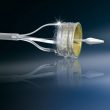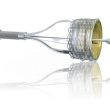This work represents the UK experience with the second generation repositionable and retrievable valve Lotus (Boston Scientific, Natick, Massachusetts). It prospectively included 228 patients of mean age 81.4 ± 7.6 and a logistic EuroScore of 17.5 ± 12.4. From the total number of patients, 187 (82%) received the valve for aortic stenosis, 7<a href="https://solaci.org/en/2016/03/08/the-largest-series-with-lotus-valve-published-so-far/" title="Read more" >...</a>
Atrial Fibrillation: Important Impact on TAVI
Original Title: Atrial Fibrillation Is Associated With Increased Mortality in Patients Undergoing Transcatheter Aortic Valve Replacement: Insights From the Placement of Aortic Transcatheter Valve (PARTNER) Trial. Reference: Angelo B. Biviano et al. Circ Cardiovasc Interv. 2016 Jan;9(1):e002766. Courtesy of Dr. Carlos Fava. The conversion to atrial fibrillation (AF) in the context of transcatheter aortic valve replacement<a href="https://solaci.org/en/2016/03/04/atrial-fibrillation-important-impact-on-tavi/" title="Read more" >...</a>
One year outcomes of the new repositionable and retrievable valve
Original Title: 1-Year Outcomes with the Fully Repositionable and Retrievable Lotus Transcatheter Aortic Replacement Valve in 120 High-Risk Surgical Patients with Severe Aortic Stenosis Results of the REPRISE II Study. Reference: Ian T. Meredith et al. J Am Coll Cardiol Intv. 2016;9(4):376-384. This analysis represents the first report at one year of 120 patients enrolled<a href="https://solaci.org/en/2016/02/23/one-year-outcomes-of-the-new-repositionable-and-retrievable-valve/" title="Read more" >...</a>
SAPIENS 3: Favorable outcomes with TAVI in intermediate risk patients
Transcatheter aortic valve replacement is a safe and effective alternative to surgery in patients with severe aortic stenosis and high surgical risk as the 5-year results of PARTNER 1 Alternate showed. The aim of this study was to evaluate the result of the Edwards Sapien 3 valve in patients with severe aortic stenosis and intermediate<a href="https://solaci.org/en/2015/06/24/sapiens-3-favorable-outcomes-with-tavi-in-intermediate-risk-patients/" title="Read more" >...</a>
ADVANCE II CoreValve Trial: Results at six months of self-expanding aortic valve
The CoreValve ADVANCE II Trial is a research study of the best practices to implement this device. Those practices included a careful assessment using scan to choose the right valve size, control the depth of the implant to 6 mm or less in relation to the valve annulus and adherence to international standards for pacemaker<a href="https://solaci.org/en/2015/06/24/advance-ii-corevalve-trial-results-at-six-months-of-self-expanding-aortic-valve/" title="Read more" >...</a>
CoreValve Evolut R CE: Good results at 6 months of the new CoreValve repositionable
This study evaluated the safety and efficacy of the new repositionable self-expanding valve. The primary end point was all-cause mortality and stroke at 30 days. 60 patients were included and the possibility for reposition was used 22 times between 12 recaptures and 10 re-sheathed of the valve. All maneuvers were carried out successfully. A 30<a href="https://solaci.org/en/2015/06/24/corevalve-evolut-r-ce-good-results-at-6-months-of-the-new-corevalve-repositionable/" title="Read more" >...</a>
NOTION: TAVR in low-risk patients
The aim of this study was to compare the results of transcatheter aortic valve replacement (TAVR) versus surgery in unselected patients with severe degenerative aortic stenosis. Patients were randomized 1:1 to TAVR (n = 145) or surgical replacement (n = 135). Those of TAVR group received Medtronic CoreValve self-expanding valve. The femoral access was used<a href="https://solaci.org/en/2015/06/24/notion-tavr-in-low-risk-patients/" title="Read more" >...</a>
BIOPACE STUDY: biventricular pacing to prevent cardiac desynchronization
Single chamber pacemaker implantation leads to a desynchronization of ventricular depolarization. This study aims to evaluate the implant of biventricular versus univentricular pacemaker. 902 patients were included in the group with biventricular pacemaker and 908 in the univentricular pacing group. The primary objective was to evaluate the long-term mortality and needs hospitalization for heart failure.<a href="https://solaci.org/en/2015/06/24/biopace-study-biventricular-pacing-to-prevent-cardiac-desynchronization/" title="Read more" >...</a>
DISCOVER Trial: Results at one year of the new nonmetallic percutaneous aortic valve
Direct Flow Medical prosthesis is a nonmetallic, repositionable, recaptured valve (even after posts dilate), that does not require a pacemakers use during both implantation and post-dilatation. The aim of this study was to evaluate new valve results to one year in patients with symptomatic severe aortic stenosis with 19 and 26 mm ring, EuroScore of<a href="https://solaci.org/en/2015/06/24/discover-trial-results-at-one-year-of-the-new-nonmetallic-percutaneous-aortic-valve/" title="Read more" >...</a>
UK TAVI Registry: Long-term results of TAVI in the UK
This record has been created in order to evaluate the results of percutaneous aortic valve replacement in the UK and currently includes more than 4500 patients with 100% follow-up for mortality. The 3-year mortality was 61.6 % beyond the device or path. Atrial fibrillation, renal failure, chronic obstructive pulmonary disease and a EuroSCORE > 18.5<a href="https://solaci.org/en/2015/06/24/uk-tavi-registry-long-term-results-of-tavi-in-the-uk/" title="Read more" >...</a>









